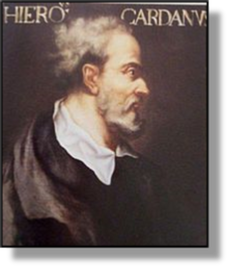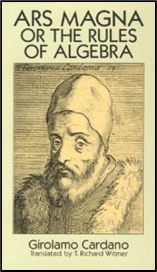


Including:
Niccolo Tartaglia
and
Lodovico Ferrari

GEROLAMO CARDANO 1501 -
xxxxxThe Italian Gerolamo Cardano produced a number of works on medical matters, but he was also a brilliant mathematician. In 1545 he published his Great Art, a milestone in the development of Algebra. In this, he put forward the algebraic solution of the cubic equation as well as that of the quartic equation, discovered earlier by his pupil Lodovico Ferrari. His Book on Games of Chance was the first known study on the theory of probability, a theory later formulated by the French mathematician Blaise Pascal.
x xxxxThe Italian Gerolamo Cardano was educated at the University of Pavia and Padua, but having gained a medical degree, spent some time lecturing in mathematics. He was admitted to the college of physicians in 1539, however, and his progress was such that by 1543 he was professor of medicine in his home town of Pavia. He produced a number of works on medical matters, one in which he gave the first clinical description of typhoid fever.
xxxxThe Italian Gerolamo Cardano was educated at the University of Pavia and Padua, but having gained a medical degree, spent some time lecturing in mathematics. He was admitted to the college of physicians in 1539, however, and his progress was such that by 1543 he was professor of medicine in his home town of Pavia. He produced a number of works on medical matters, one in which he gave the first clinical description of typhoid fever.
xxxxxBut it would seem that his first love was mathematics. He wrote two books on arithmetic equations, based on his lectures, but it was his Great Art, published in 1545, that proved a milestone in the development of algebra  and helped to stimulate greater interest in this particular branch. In this, the first competent Latin treatise on the subject, he put forward not only the algebraic solution of the cubic equation -
and helped to stimulate greater interest in this particular branch. In this, the first competent Latin treatise on the subject, he put forward not only the algebraic solution of the cubic equation -
xxxxxHis Book on Games of Chance was the first known study on the theory of probability -
xxxxxThe Italian mathematician Niccolo Tartaglia (c1499-
 xxxxxAs noted above, it was the Italian mathematician Niccolo Tartaglia (c1499-
xxxxxAs noted above, it was the Italian mathematician Niccolo Tartaglia (c1499-
xxxxxTartaglia's interest in mathematics was not purely academic. He put his knowledge to practical use on the battlefield, probably the first mathematician to do so. In his Nova Scientia, published in 1537, he described new instruments and ballistic procedures by which gunnery could be improved, and he attempted to trace the trajectory of a missile based on speed and elevation. In addition, he suggested the disposition of artillery and the type of fortifications which were best suited to various types of terrain. During his career he produced a number of texts on mathematics -
ballistic procedures by which gunnery could be improved, and he attempted to trace the trajectory of a missile based on speed and elevation. In addition, he suggested the disposition of artillery and the type of fortifications which were best suited to various types of terrain. During his career he produced a number of texts on mathematics -
xxxxxIncidentally, when Tartaglia gave Cardano the algebraic solution or root of the cubic equation, it was on the understanding that he should not make it public. Thus when, nevertheless, Cardano published the solution in his Great Art in 1545, a quarrel broke out between the two men. Lodovico Ferrari (1522-



Acknowledgements
Cardano: date and artist unknown – School of Mathematics and Statistics, University of St. Andrews, Fife, Scotland. Tartaglia: detail of statue, photo by Math Guys – Pincian Gardens, Rome. Gunnery: illustration from Tartaglia’s Nova Scientia – Max Planck Institute for the History of Science, Berlin.
H8-